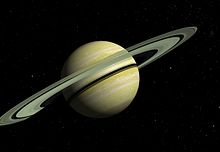Iota Horologii b
Iota Horologii b (ι Hor b / ι Horologii b), often catalogued HR 810 b, is an extrasolar planet approximately 56.5 light-years away in the constellation of Horologium (the Pendulum Clock). Iota Horologii b has a minimum mass 1.94 times that of Jupiter; however, preliminary astrometric measurements suggest that the object may be around 24 Jupiter masses and would therefore be a brown dwarf.
 Planet Iota Horologii b (min mass ~2.2 MJ) with Saturn-like rings, and a sulfuric stained atmosphere | |
| Discovery | |
|---|---|
| Discovered by | Kürster et al. |
| Discovery site | La Silla Observatory |
| Discovery date | 29 July 1999[1] |
| Doppler spectroscopy | |
| Orbital characteristics | |
| 0.91 AU (136,000,000 km) | |
| Eccentricity | 0.22 ± 0.06 |
| 311.3 ± 1.3 d | |
| 2,451,308.8 ± 10.4 | |
| 78.9 ± 13.1 | |
| Semi-amplitude | 57.1 ± 5.2 |
| Star | Iota Horologii |
Detection and discovery
The discovery of Iota Horologii b was the result of a long-term survey of forty Solar analog stars that was begun in November 1992. The planet represents the first discovery of an extrasolar planet with a European Southern Observatory instrument, with the data found at the La Silla Observatory in Chile.
The Keplerian signal found the planet to have an orbital period of 320.1 days, indicative of an orbiting planet with minimum mass of 2.26 Jupiter masses.[2] Iota Horologii b was announced in the summer of 1999 as the first planet found by a team of planet hunters led by Martin Kürster.[1]
The measurements of Iota Horologii show that the planet orbits the star approximately every 320 days. From this period, the known mass of the central star (1.25 solar masses)[3] and the amplitude of the velocity changes, a mass of at least 2.26 times that of planet Jupiter is deduced for the planet.
It revolves around the host star in a somewhat elongated orbit. If it were located in the Solar System, this orbit would stretch from just outside the orbit of Venus (at 117 million km or 0.78 astronomical units [AU] from the Sun) to just outside the orbit of the Earth (at 162 million km or 1.08 AU). Because the planet is at least 720 times more massive than the Earth, it is predicted that Iota Horologii b is more similar to planet Jupiter.
In recent astrometric analysis of Iota Horologii b suggests that planet b may have as much as 24 times the mass of Jupiter with an inclination of 5.5 degrees from Earth's line of sight. With this calculations, Iota Horologii b may actually be an extremely dim brown dwarf and a substellar companion of Iota Horologii. However, these measurements were later proved useful only for upper limits of inclination.[4]
See also
References
- "Extrasolar Giant Planet in Earth-like Orbit" (Press release). Garching, Germany: European Southern Observatory. July 29, 1999. Retrieved December 29, 2012.
- Kürster, M.; et al. (2000). "An extrasolar giant planet in an Earth-like orbit. Precise radial velocities of the young star iota Horologii = HR 810". Astronomy and Astrophysics. 353 (3): L33–L36. Bibcode:2000A&A...353L..33K. Archived from the original on 2011-07-25. Retrieved 2011-12-21.
- https://www.eso.org/public/images/eso0809a/
- Pourbaix, D.; Arenou, F. (2001). "Screening the Hipparcos-based astrometric orbits of sub-stellar objects". Astronomy and Astrophysics. 372 (3): 935–944. arXiv:astro-ph/0104412. Bibcode:2001A&A...372..935P. doi:10.1051/0004-6361:20010597.
External links
- "Extrasolar Giant Planet in Earth-like Orbit". European Southern Observatory. Archived from the original on 2008-10-13. Retrieved 2008-06-12.
- "Iota Horologii". SolStation. Retrieved 2008-06-12.
- "The Planet Around HD17051". California & Carnegie Planet Search Team. 2003-05-04. Archived from the original on 2008-05-18. Retrieved 2008-06-12.